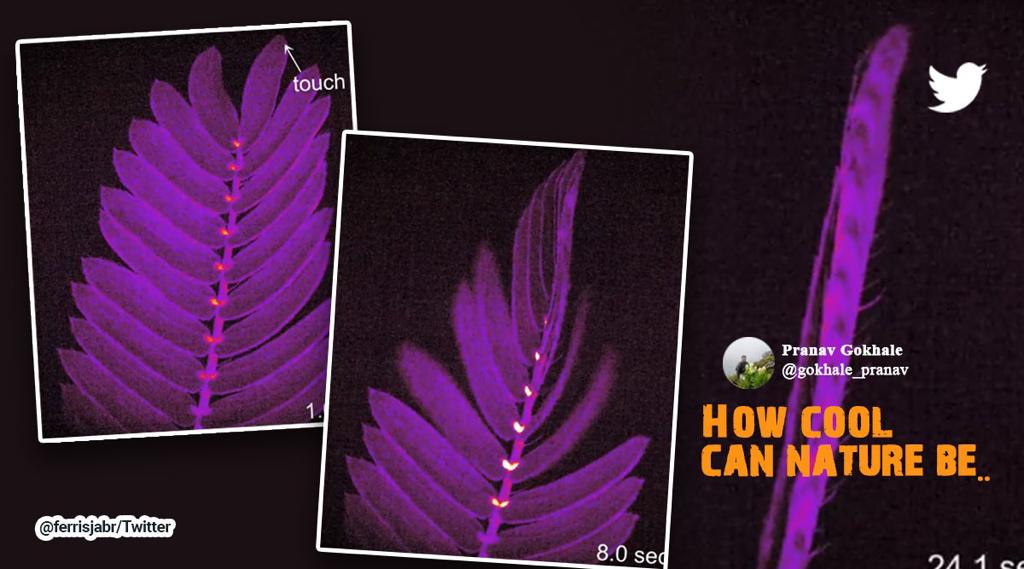‘So cool’: Science writer explains why touch-me-not plants wilt
Mimosa pudica is known by various names around the world such as ‘chuimui’, ‘hilahila’, and ‘lozzaboti’.

Mimosa pudica that folds its tiny leaves in response to the slightest of touches is one of the most fascinating plants in the world. It is found in tropical and semi-tropical environments around the world and goes by many local names such as ‘chuimui’, ‘hilahila’, and ‘lozzaboti’.
On Saturday, a science writer shared videos that captured how ‘electrical signals’ within the plant trigger its folding effect. Ferris Jabr shared the videos that were taken by Japanese scientists for a 2022 study published in Nature Communications, a scientific journal.
Jabr shared the video that showed the plant’s electrical impulses getting generated and its leaves folding due to the presence of an insect on it. He wrote, “Exactly why Mimosa pudica and other plants fold their leaves is not definitively known. Hypotheses include reducing water loss, exposing thorns, startling insects, and giving the appearance of a less voluminous meal. Here, M. pudica folds in response to a munching grasshopper”.
In this video, from the same recent study, you can see how an injury at the tip of an M. pudica leaf generates an electric impulse that travels down the length of the leaf to the base, triggering folding along the whole branch pic.twitter.com/ZGfx7RUScW
— Ferris Jabr (@ferrisjabr) November 19, 2022
Although plants don’t have neurons or muscles, they are electric—all cellular organisms are. Plants can generate waves of charged particles that travel quickly from one part of their body to another and trigger quick movementshttps://t.co/ymODJYIva2 pic.twitter.com/hYj6bWSqG2
— Ferris Jabr (@ferrisjabr) November 19, 2022
Indeed they do, and the underlying mechanism is very similar. I wrote a detailed article here if you’re interested: https://t.co/ymODJYIva2
— Ferris Jabr (@ferrisjabr) November 20, 2022
To explain this behaviour further, Jabr said, “Although plants don’t have neurons or muscles, they are electric—all cellular organisms are. Plants can generate waves of charged particles that travel quickly from one part of their body to another and trigger quick movements”.
His tweets soon gathered thousands of views and likes. Commenting on Jabr’s tweets, a Twitter user wrote, “Wow! Amazing video. I grew up in Hawaii, where M. pudica is known as “Hilahila”, meaning ‘bashful’ or ‘ashamed’. It is a common and much-despised weed there.”
Good to see how electric signals mediate rapid leaves movement differently!
A mystery behind the ‘Touch Me Not” Plant!
— Shyam PHARTYAL| 🦣ID @shyamphartyal@ecoevo.social (@shyamphartyal) November 20, 2022
I first saw this plant as a child at a museum and I was always disappointed when I encountered a similar-looking plant when out and about that did not exhibit the same ‘behavior’. Also, I never thought about plants as having electrical signals. So cool! https://t.co/liGZ6VwL7Q
— Insidiator PhotoFish (@InsidiatorPhoto) November 20, 2022
Wow! Amazing video. I grew up in Hawaii, where M. pudica is known as “Hilahila”, meaning ‘bashful’ or ‘ashamed’. It is a common and much-despised weed there.
— Gordon Haas (@DaKineOregon) November 20, 2022
Growing up in Singapore, these “touch-me-nots” were everywhere. They’re far rarer now though.
— Jasmin Malik Chua (@jasminchua) November 19, 2022
We call them “lozzaboti” loosely translated as shy plants in Bangladesh
— Asif Dowla (@audowla) November 19, 2022
Another person said, “I first saw this plant as a child at a museum and I was always disappointed when I encountered a similar-looking plant when out and about that did not exhibit the same ‘behavior’. Also, I never thought about plants as having electrical signals. So cool!”
- 01
- 02
- 03
- 04
- 05































